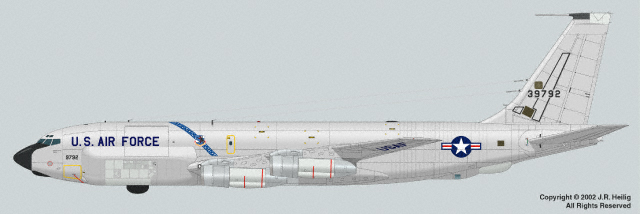|
C-135 Variants - Part 6
by Jennings Heilig
|
 |
|
1. KC-135A 59-1481
"Weightless Wonder IV", Ellington Field, Houston, Texas, 1992
|

HyperScale is proudly supported by
Squadron.com
Here are four more colour profiles of C-135 variants prepared in
Illustrator:
1. KC-135A 59-1481 "Weightless Wonder
IV", Ellington Field, Houston, Texas, 1992 (Title Profile Above)
This is NASA's venerable "Vomit Comet." N930NA was the fourth
C-135 variant used in this role, having served longer than any other
(1973-1995). If you've seen a photo or video of astronauts or
scientists floating around in simulated zero-G, it was probably shot
aboard this aircraft. She now rests in honorable retirement outside
the gate at Ellington.
2. RC-135C 63-9792, 55th Strategic
Reconnaissance Wing, Offutt AFB, Nebraska, 1967

Boeing produced ten RC-135Bs which were delivered directly into
long term storage with Martin Aircraft in Baltimore, Maryland in
1964 and early 1965. After much modification over the next two
years, the bare RC-135Bs were transformed into "Big Team" RC-135Cs.
The RC-135C represented a quantum leap in SIGINT collection
capability over the RB-47H that it replaced, and it was claimed to
be able to scoop up "everything from DC to light".
This aircraft was the first RC-135C delivered to SAC (on 27
January 1967), and it was later converted to an RC-135U and then to
an RC-135V, where it remains active today.
These next two are the first in a series of profiles of this
historic airframe:
3. KC-135A 55-3121, Wright Air
Development Center, Air Research & Development Command,
Wright-Patterson AFB, Ohio, 1959

KC-135A 55-3121 is perhaps the most historically significant
airframe in the entire C-135 family.
She was the first KC-135A handed directly to the USAF from
Boeing's assembly line, rather than being retained for company
testing. She is shown here as she appeared early in her career as a
testbed with the ARDC's Wright Air Development Center in the late
1950s.
At this time her duties included Arctic and desert testing,
adverse weather testing, and she was used as an icing test spray
aircraft.
The color scheme is fairly standard for the late 1950s, with
fluorescent red-orange (faded by the sun to a more orange color) and
a fashionable white crown over the cockpit area.
4. KC-135A 55-3121, Speed Light Alfa, 30 October 1961

Soviet Premier Nikita Kruschev announced the intention of the
USSR to explode a 100 megaton nuclear device on the island of Novaya
Zemlya during the tense spring of 1961. The USAF intelligence
community instituted a crash program to modify three KC-135As under
the project name "Speed Light" to collect data on this enormous
explosion (the largest ever attempted before or since).
There is some mystery surrounding exactly what happened, and
when it happened, to the airplanes in this project, but it is fairly
certain that 55-3121 was the primary aircraft used. In the event,
the explosion only (only) yielded 58 megatons, which was lucky for
the crews of the "Speed Light" airplanes.
As it was they were close enough to feel the scorching effects
of the massive blast, and had it in fact yielded the desired 100
megatons, likely that would have been the end of the story for this
airplane and her crew. Little is known of what unit(s) operated the
"Speed Light" aircraft, nor of the brave crews who manned them.
Text and Images Copyright © 2002 by
Jennings Heilig
Page
Created 01 January, 2003
Last updated
01 January, 2003
Back to HyperScale Main
Page
Back to Reviews
Page
|
Home |
What's New |
Features |
Gallery |
Reviews |
Reference |
Forum |
Search